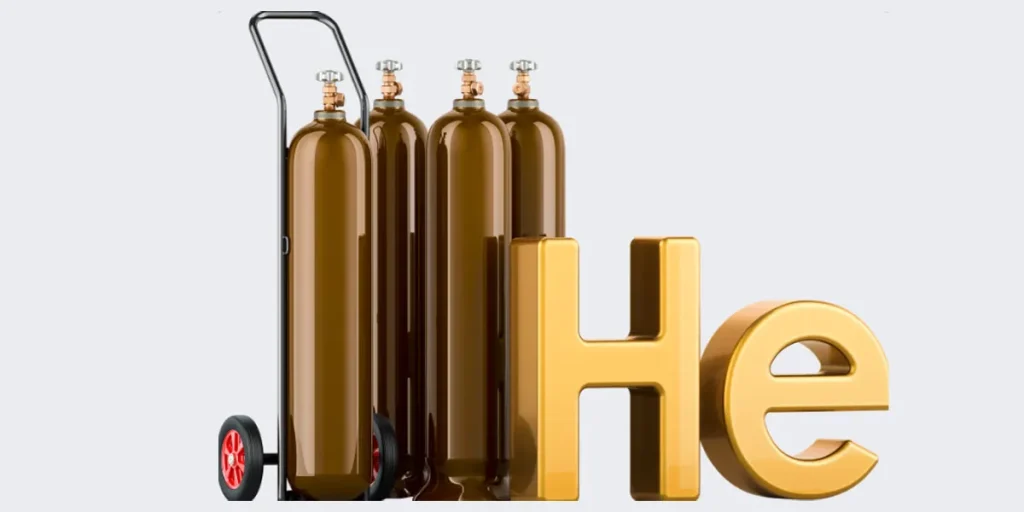Helium has a density of 0.1786 grams per liter at 0°C and 1 atmosphere. This value represents helium’s weight under standard conditions.
Helium, the second lightest element and a noble gas, occupies a unique niche due to its weightlessness and non-reactive nature.
Found in the Earth’s atmosphere in trace amounts, helium is far lighter than air, which explains its common use in balloons and airships.
Scientists and industry professionals often take advantage of helium’s properties in applications ranging from cryogenics to leak detection.
Its low boiling and melting points make it ideal for supercooling materials. As a content writer focused on delivering concise information, it’s essential to highlight helium’s utility across various sectors.
The gas plays a crucial role in medicine, aeronautics, and technology, making its lightweight characteristic more than just a party trick—it’s an integral part of innovations that drive progress.
The Basics Of Helium
Helium is not just for balloons and funny voices. It’s a chemical element with unique properties. This section will shed light on its fascinating aspects.
What Is Helium?
Helium is a colorless, odorless, tasteless, non-toxic, inert gas. It is the second lightest and second most abundant element in the observable universe.
Most people know it as the gas that makes balloons float. Here are some quick facts:
- Atomic number: 2
- Symbol: He
- Phase at room temperature: Gas
Scientists use helium in cryogenics, pressurizing and purging systems, and in controlled environments.
Helium In The Periodic Table
In the Periodic Table, helium sits at the top of the noble gases group. This group is also known as the inert gases. The details of helium in the periodic table include:
| Group | Period | Block | Category |
|---|---|---|---|
| 18 | 1 | s | Noble gases |
Besides being a noble gas, it has the lowest boiling and melting points. This scientific fascination is not just for its scarcity on Earth, but also for its role in space and technology.
Delving Into Density

Welcome to the world of helium, a gas lighter than air with fascinating properties.
Density Of Gases
Understanding a gas’s density is key to grasping its weight. Density is the mass per unit volume and is expressed in kilograms per cubic meter (kg/m3) for gases.
To visualize it, picture how compact or spread out the particles are in a given space.
Density of common gases (at standard temperature and pressure):
| Gas | Density (kg/m3) |
|---|---|
| Helium | 0.1786 |
| Air | 1.225 |
| Hydrogen | 0.08988 |
| Nitrogen | 1.2506 |
These values show why some gases float while others sink.
Helium Compared To Air
Helium floats because it has less mass in the same volume than air. Its density is much lower. This is why helium balloons rise gracefully into the sky.
- Helium’s density: 0.1786 kg/m3
- Air’s density: 1.225 kg/m3
This comparison tells us that helium is about seven times less dense than air. Hence, a helium-filled balloon or container will be much lighter than one filled with air.
Measuring The Immeasurable

Think about weighing something that is almost not there; it sounds like a magic trick, right? Measuring the Immeasurable challenges our understanding of weight.
The element helium, light and elusive, tests the limits of our measuring tools. Let’s unravel how scientists weigh this tiniest of dancers in the elemental ballroom.
The Weight Of Helium
Helium is famously lightweight.
At sea level, one liter of helium weighs about 0.1785 grams – lighter than the air around us.
This is why balloons filled with helium rise. Beneath its playful use, helium has a precise weight crucial for science and industry.
| Volume | Weight at Sea Level |
|---|---|
| 1 Liter | 0.1785 grams |
Calculating The Mass Of A Helium Atom
Atoms are the tiny building blocks of matter.
To find a helium atom’s mass, scientists use the atomic mass unit (amu).
- One helium atom has an atomic mass of approximately 4 amu.
- The amu is incredibly small, about 1.66 x 10-24 grams.
To arrive at helium’s atomic weight:
- Multiply the atomic mass (4 amu) by the mass of one amu.
- This gives the helium atom a weight of roughly 6.64 x 10-24 grams.
Helium’s Uses And Applications
Let’s shed some light on Helium’s uses and applications. This noble gas, light and non-reactive, plays pivotal roles in various industries.
From lifting to cooling, helium’s unique properties make it invaluable. Now, let’s delve into the specifics, exploring helium’s remarkable versatility.
In Balloons And Blimps
Helium is best known for its role in keeping balloons afloat. Due to its lighter-than-air status, it’s the perfect choice for both party balloons and large advertising blimps. This gas ensures that:
- Party balloons hover beautifully.
- Blimps can rise without heating the gas.
- Parades feature gigantic, sky-high characters.
Cooling Systems And Scientific Research
In the realms of technology and science, helium becomes a super-coolant. Its low boiling point allows it to cool materials to near absolute zero. This is critical for:
| Application | Use |
|---|---|
| MRIs | Cools the magnets for clear images. |
| Particle Accelerators | Keeps equipment at optimal performance. |
| Cryogenics | Possible because of helium’s extreme cold. |
Not just a cooling agent, helium aids in scientific exploration. Researchers rely on helium to:
- Protect delicate samples.
- Carry out high-precision experiments.
- Run tests without chemical reactions.
The Economic Perspective
The Economic Perspective brings an intriguing angle when discussing the weight of helium.
While helium itself is light, the costs associated with its extraction, distribution, and usage carry a significant economic weight.
This section delves into the financial aspects behind this noble gas that floats above simplistic weight measures.
Cost Of Helium
Helium is precious and its pricing reflects that. Various factors determine helium’s cost:
- Purity levels – Higher purity means higher prices.
- Extraction costs – It’s often a byproduct of natural gas, making recovery expensive.
- Transportation – Helium requires special containment, adding to transport fees.
The price is volatile, varying by region and demand. Here’s an illustration of helium prices over time:
| Year | Price per thousand cubic feet (USD) |
|---|---|
| 2018 | $280 |
| 2019 | $350 |
| 2020 | $210 |
The Helium Market
The helium market has its own dynamics. It’s shaped by demand in industries like:
- Healthcare – for MRIs and other medical equipment.
- Technology – in manufacturing electronic devices.
- Research – for scientific exploration and discovery.
Balloons are a known use, but they represent a small portion. Supply constraints and geopolitical factors can impact the market, leading to price fluctuations.
For instance, the 2017 Qatar blockade disrupted the market as Qatar is a key supplier. Understanding the helium market offers insight into its cost patterns, influencing buyer behavior and investment decisions in this invisible commodity.
Environmental And Conservation Concerns
The weight of helium may seem like a simple scientific fact. Yet, it raises complex environmental issues.
Helium is not only important for balloons and blimps. It has key roles in medical and scientific fields. These roles often go unnoticed.
Helium Scarcity
Helium is becoming scarce. This element is non-renewable. Once released into the atmosphere, it escapes into space.
Earth’s supply is finite. As we use it, the available amount decreases. This scarcity poses a risk.
Here is why helium scarcity matters:
- Medical uses: Helium is crucial for MRI machines.
- Scientific research: It’s used in particle accelerators and space exploration.
- Technology: Helium is important for manufacturing electronic devices.
Sustainability Efforts
With helium’s crucial role, sustainability efforts are vital. The goal is to reduce waste and recycle.
Efforts include:
- Developing technologies to capture and recycle helium.
- Promoting the use of helium alternatives where possible.
- Establishing conservation policies.
These actions help preserve helium for future generations.
FAQs About the Weight of Helium
What Is The Weight Of Helium Per Liter?
Helium has a very low density at 0. 1786 grams per liter at standard temperature and pressure (STP).
Because it’s lighter than air, it’s often used for balloons and blimps.
How Does Helium’s Weight Compare To Air?
Helium is lighter than air. Air weighs about 1. 225 grams per liter, while helium weighs approximately 0. 1786 grams per liter.
This significant difference allows helium-filled balloons to float.
Can Helium’s Weight Change Under Pressure?
Yes, helium’s weight can change under pressure. When compressed, the density increases, and thus, the weight per unit volume increases.
However, it remains lighter than air, regardless of the pressure.
What Factors Affect Helium’s Weight?
Factors affecting helium’s weight include temperature and pressure.
Colder temperatures and higher pressures increase helium’s density and weight, whereas higher temperatures and lower pressures decrease it.
Conclusion
Understanding the weight of helium has practical importance for many fields, from party planning to rocket science.
Despite being the second lightest element, its weight can impact various applications, from inflating balloons to propelling spacecraft. We’ve explored its mass and how conditions affect it.
Remember, helium’s lightweight characteristics are as fascinating as they are beneficial. Keep this guide in mind for your next helium-related undertaking.
Resources:
https://www.blm.gov/programs/energy-and-minerals/helium/about-helium
